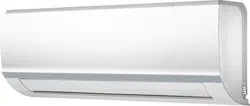Loading ...
Loading ...
Loading ...

IM-40MHH-02 Specifications subject to change without notice. 11
3.
Use the holder in the mounting plate to prop up the unit,
allowing you enough space to connect the refrigerant
piping, signal cable, and the drain hose
.
Fig. 16 — Use Holder to Prop up the unit
3. Connect the drain hose and refrigerant piping.
4. Keep the pipe connection point exposed to perform the leak test.
5. After the leak test, wrap the connection point with insulation tape.
6. Remove the bracket or wedge that is propping with insulation tape.
7. Using even pressure, push down on the bottom half of the unit.
Keep pushing down until the unit snaps onto the hooks along the
bottom of the mounting plate.
If there is no refrigerant piping embedded in the wall, perform the
following steps:
1. Based on the position of the wall hole relative to the mounting
plate, choose the side from which the piping will exit the unit.
2. If the wall hole is behind the unit, keep the knock−out panel in
place. If the wall hole is to the side of the indoor unit, remove the
plastic knock−out panel from that side of the unit (see Fig. 17). This
creates a slot through which your piping can exit the unit. Use
needle nose pliers if the plastic panel is too difficult to remove by
hand.
Fig. 17 — Knock Out Panel
3. Use scissors to cut down the length of the insulating sleeve to reveal
about 1.57in. (40mm) of the refrigerant piping.
This serves two purposes:
(1.) To facilitate the refrigerant piping connection process
(2.) To facilitate Gas Leak Checks and enable you to check for
dents.
4. Connect the indoor unit’s refrigerant piping to the connective
piping that joins the indoor and outdoor units.
5. Based on the position of the wall hole relative to the mounting
plate, determine the necessary angle of your piping.
6. Grip the refrigerant piping at the base of the bend.
7. Slowly, with even pressure, bend the piping towards the hole. Do
not dent or damage the piping during the process.
Knock-out Panel
Loading ...
Loading ...
Loading ...
